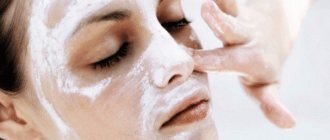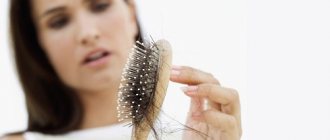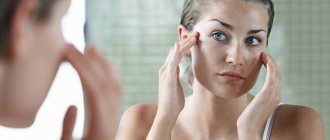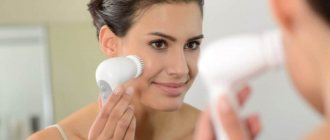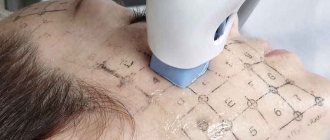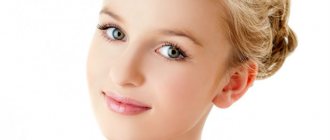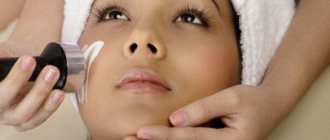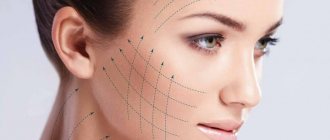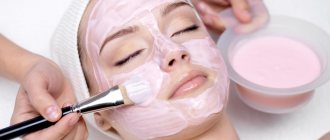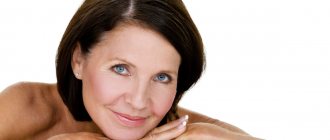A well-groomed face helps to make a positive impression and encourages communication. People like to please both each other and themselves. Without any doubt, having a beautiful face is now not just fashionable, but vital. In this regard, new technologies are coming to the aid of humanity, facilitating the process of caring for the face and body and freeing up such a valuable reserve as time for people. One of these newfangled procedures is mustache photoepilation, which helps both women and men achieve smooth and velvety facial skin.
Features of facial photoepilation
Facial photoepilation is a common procedure, the principle of which is based on the formation of a focused beam of light by a special device. The light beam affects the hair root and destroys the hair follicle. Accordingly, the hair will no longer be able to grow in this place. The light beam is absorbed by the melanin contained in the hair, sent to its root, converted into heat, which has a destructive effect.
Among the advantages of the procedure is its high speed - depending on the treatment area, the procedure takes from 5 to 20 minutes, the “antennae” area is cleared of excess hair in 15 seconds. The manipulation is effective on all shades of hair and skin (with the exception of transparent, gray hairs, completely devoid of melanin). It is used on all areas - from legs to face, deep bikini; after treatment, processes of active regeneration, production of collagen, elastin, and rejuvenation are launched in the epidermis. The technique is as gentle as possible - the skin is not damaged, there are no burns.
The procedure was first used in the late 1990s. It became widespread a few years later, when its safety was confirmed by official medical research.
Photoepilation – Price in our clinics
| Photoepilation (1 flash) | Price: 100 rub. | Price: 200 rub. |
Getting rid of unwanted hair is quite difficult, but progress is being made, technology is improving, and a solution to this problem has already been found.
Photoepilation is a hair removal technique based on the destruction of the hair follicle by exposing it to strong flashes of light. This effect is achieved due to the ability of the melanin pigment to absorb light impulses.
The hair follicle is heated and destroyed under the influence of photo rays. Thus, after the first photoepilation session, 50% of unwanted hair disappears, and after several procedures - almost 100%.
The most common areas for photoepilation are:
- shins;
- intimate area;
- hands;
- area above the upper lip (“moustaches”).
- armpits;
Preparation
In order for the procedure to be effective, efficient, and not cause harm, it is necessary to carefully prepare for it. To do this, follow a number of rules:
- Consult a dermatologist about the condition of your skin and the admissibility of treatment in this way;
- Consult with the specialist with whom you are directly going to perform the procedure - about the effectiveness of the manipulation, the estimated required number of procedures, the advisability of choosing this particular technique in a particular case;
- Two weeks before the procedure, you should avoid visiting solariums and exposing your skin to direct sunlight, use sunscreen with a filter of at least SPF 30 whenever going outside during daylight hours, wear hats with wide brims and visors;
- Do not use self-tanning or other skin tinting products;
- Refuse to remove hair on the treated area a month before the manipulation - during this period they will grow to a sufficient length to completely absorb and conduct a beam of light to the root of the hair;
- If possible, stop taking medications (especially antibiotics, antipsychotics, antidepressants, tranquilizers) at least a week before the procedure (consult your doctor).
There may be other contraindications - this must be taken into account when visiting a dermatologist on the eve of the photoepilation procedure.
Contraindications
Photoepilation, despite all the positive properties of this technique, is not permitted for all categories of people. This procedure is prohibited if you have certain conditions.
Contraindications to such manipulations:
- the presence of a tan that has just appeared on the skin surface, including self-tanning;
- taking certain medications - antibacterials, retinoids;
- the presence of dermatological problems in the area of future exposure;
- rash of an allergic nature;
- diabetes;
- oncological diseases;
- neuropsychiatric disorders;
- diseases of the heart and cardiovascular system;
- infectious diseases;
- increased body temperature;
- exacerbation of existing chronic pathologies;
- age up to 16 years.
You cannot hide from a cosmetologist the presence of certain conditions in which the procedure would be prohibited. This can cause serious side effects that pose a risk to human health.
How is the procedure done?
The traditional photoepilation procedure includes the following steps:
- The patient comes into the office, lies down on the couch;
- The facial skin in the treated area is cleansed of dirt/makeup;
- A composition is applied to the area that can slightly numb the pain, have an antiseptic effect, protect the skin from burns and light damage during the procedure - usually this is a water-based hypoallergenic gel;
- The patient's (and the technician's) eyes are covered with special glasses to avoid burns;
- The technician turns on the device, directing its working surface to the problem area, waiting for the flash;
- Flashes occur every 5 seconds, after each of them the device moves - the adjacent area is processed;
- This method treats the entire problem area;
- The protective gel is removed from the skin;
- A soothing composition is applied to it, accelerating regeneration and recovery.
Depending on the area being treated, the duration of the procedure varies, but is always short - photoepilation of the eyebrows, mustache area takes 5-10 minutes, chin area, sideburns - 10-15 minutes.
About the equipment
In our clinic, using innovative Italian equipment Deka Synchro FT, photoepilation of the upper lip, armpits, bikini, legs, etc. is carried out. Even on sensitive areas of the body, the procedure is painless and safe. The possibility of mechanical damage to the skin and infection is excluded. Due to the latest cooling system, burns are also unlikely. The procedure is effective for removing light, red hair on tanned, dark skin. The same device is used to perform laser hair removal and spider vein removal.
Eye precautions
During the procedure, the device generates powerful beams of high-intensity light aimed at the treated areas. Regardless of which specific area is being treated, there is a possibility of retinal damage and burns. But the closer the treatment area is to the eyes, the higher this probability.
For protection purposes, simple sunglasses are not suitable, since they still allow some of the rays to pass through. The patient puts on special plastic devices, the edges of which fit tightly to the skin and are completely opaque. The master puts on translucent safety glasses, through which visibility is sufficient to perform the procedure.
Is it possible to remove eyebrows with a photoepilator?
Any area can be treated with a photoepilator, as this is an accurate, gentle method. Although there is a greater chance of eye damage in the process, safety glasses can help prevent retinal burns. They are small in size and do not cover the eyebrow area at all.
The accuracy of the light beam is not so great that it can be used to perform high-quality eyebrow correction. But the accuracy of the procedure is sufficient for complete removal of eyebrows (with an alternative style or the intention to later apply them with microblading), and cleaning of excess hair from the bridge of the nose (if fused).
Facial skin care after the procedure
During the procedure, minor damage to the skin and burns from beams of light occur. In order to avoid serious consequences of this phenomenon, it is necessary to carefully care for the skin after the intervention, follow the following rules:
- If swelling, redness, and mild pain in the treatment area do not disappear even a couple of hours after the procedure, cool the affected area with a compress;
- In case of severe discomfort, it is permissible to take non-steroidal anti-inflammatory drugs as needed, but not more than 3 tablets per day (Ibuprofen, Nurofen);
- Healing agents - Panthenol, Bepanten - are applied twice a day for a week (this is not always necessary, it is discussed individually with the specialist);
- For a week, do not use cosmetics on the treated area, especially those containing alcohol;
- For the same period, refrain from visiting swimming pools, saunas, baths, natural reservoirs, and do not steam in the bathroom;
- For two weeks, protect your face from direct sunlight by wearing hats with visors/wide brims, and use sunscreen with a filter of less than SPF 30 from the second week after the procedure.
Depending on the characteristics of the patient’s skin and the location of the procedure, there may be other restrictions and recommendations. This issue is resolved with the master on an individual basis.
Epilation
Epilation is a method of removing eyebrow hairs to give them the desired shape and correct some imperfections (fused eyebrows, for example) using tweezers, wax or special equipment. This is one of the main methods of eyebrow shape correction, helping to visually highlight all the advantages of your appearance.
How to epilate at home
The good thing about home hair removal is that you can do it at any time convenient for you. In addition, this procedure will not require any special financial costs, which is a huge advantage in our time.
Hair removal with tweezers - cheap and fast
With tweezers - 1 way
Did you know that about 93% of women turn to tweezers for eyebrow hair removal? This is due to the relative simplicity and convenience of the procedure.
But there are many nuances on which the success of the session depends:
- Correct determination of the future shape of the eyebrows. To do this, you need to attach a long pencil or other object of a similar shape to the nostril and lean it through the inner corner of the eye to the beginning of the eyebrow. A visually drawn line through the middle of the eye will indicate the highest point of the eyebrow, and a line passing through the outer corner will indicate its end.
- Sterility, sterility and sterility again! Never use an instrument that has not been disinfected! Before starting work, it is best to lubricate it with an alcohol-containing lotion, otherwise you risk catching some kind of infection.
Always use only clean, sterile instruments
- No masochism. Eyebrow plucking is not the most painless procedure, but it is better to minimize all unpleasant sensations. This can be done with an ice cube or a hot compress applied to the treated area.
- More doesn't mean better! In the process of removing eyebrows with your own hands, there is no need to rush to get rid of all the seemingly unnecessary hairs. It is better to do this gradually, carefully examining the result in the mirror.
So you may simply end up with thin, thread-like eyebrows, which have long been out of fashion. Believe me, the process of waiting for hairs to grow can take a long time and you won’t like it.
Recommendation! If you are plucking for the first time and are not confident in your abilities, it is better to consult a specialist. He will indicate the most suitable shape, all you have to do is maintain it.
The price for such a service in a salon or hairdresser varies depending on the region, in general its cost is approximately 150-200 rubles.
By contacting a professional, you will get the perfect eyebrow shape like the recognized beauties from advertising photos
Waxing - method 2
Waxing, also known as waxing, is an ideal option for removing the shortest hairs that are very difficult to catch with tweezers. By getting rid of excess hair on different parts of the body, you can spend the remaining wax on correction and hair removal in the eyebrow area.
After waxing, you will get rid of the need to remove excess hair for several weeks.
The waxing process is not particularly complicated. You will need:
- wipe eyebrows with alcohol-containing lotion;
- cover the treated area with a small amount of talc or powder;
- Apply a thin layer of heated wax along the hair growth. Do this carefully so as not to touch hairs that should not be removed;
- attach a piece of cloth or a special paper strip to the wax;
- With a sharp movement against the growth of hairs, tear off the strip along with the wax.
The main disadvantage of waxing is that repeating the procedure too often is not recommended. In addition, it cannot be performed if the skin is too sensitive or allergic to the components.
Photo gallery of faces before and after hair removal
The first effect after the procedure is noticeable immediately. Getting rid of hair lasts for six months or a little less. After this, the sleeping follicles “wake up” - hairs begin to grow out of them, thinner, lighter, and more brittle. Destroyed follicles are not restored.
To obtain a long lasting effect, at least 6-8 procedures will be required. They can be carried out, depending on the type of skin, hair, and treatment area, at intervals of two to six weeks. The stability of the effect depends on the state of human health, the amount of male sex hormones, genetic predisposition, and the characteristics of skin and hair regeneration.
What hair removal looks like on the face can be seen in the photo in the material.
Why do women have mustaches ↑
Hair grows on the entire surface of human skin, except the palms and soles, so moderate facial hair is natural. Of course, acceptable standards differ for men and women. It's all about testosterone - the male hormone. Despite the fact that it is often called “male”, it is also present in the blood of women in much lower concentrations, therefore, as a rule, women’s skin is covered with only a delicate fluff. But when the body malfunctions or heredity interferes, then the hated long and coarse hairs appear above the lady’s upper lip, as well as in other places of the body. Undoubtedly, mustaches are not the best decoration for ladies. What reasons lie behind such problems?
A mustache for a woman is an extra “decoration”
- Natural
Dear ladies, have you ever noticed that those with “hot” blood are generously endowed with hair on their bodies? Then you shouldn’t be surprised if one of your ancestors was from the Caucasus or the East - your “mustache” was simply passed down from generation to generation. Of course, you have the right to get rid of such “gifts” from your parents, but you should not be nervous about your abnormality. As for the “stronger sex”, there is nothing to explain here - they are given an abundant mustache by nature, but how to manage it is everyone’s business.
- Purchased
Unnaturally, antennae may appear due to illness or as a result of taking certain medications. Hormonal imbalances, menopause, cancer or ovarian cysts - all this can provoke the appearance of vegetation. A specialized doctor can tell you whether you can get rid of hair due to such circumstances. For example, it is not recommended to interrupt the intake of certain medications, which means you need to wait until the end of the course of treatment and then deal with excess vegetation.
Even a generous layer of foundation doesn't hide the nasty mustache
